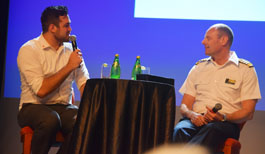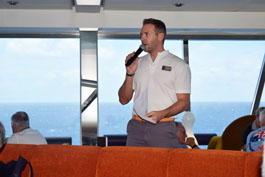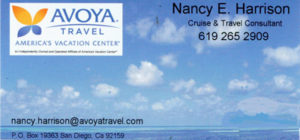

Editor’s Note: This is the 30th in a series of stories researched during Don and Nancy Harrison’s 50th Wedding Anniversary cruise from Sydney, Australia, to San Diego. Previous installments of the series, which runs every Thursday, may be found by tapping the number of the installment: 1, 2, 3, 4, 5, 6, 7, 8, 9, 10, 11, 12, 13, 14, 15, 16, 17, 18, 19, 20, 21, 22, 23, 24, 25, 26, 27, 28, 29
By Donald H. Harrison

AT SEA, Aboard MS Maasdam – As far as Nancy and I were concerned, the journey from Sydney, Australia, to San Diego was one continuous adventure. On the books of Holland-America Line, however, we were having two adventures. The first was the cruise segment from Sydney to Auckland, New Zealand. The second was the cruise segment from Auckland to San Diego. This meant that many of the passengers who embarked in Sydney completed their cruise vacations in Auckland, and their places on the ship were taken by new passengers who boarded in Auckland and would remain aboard until San Diego. This changing of the guard did not apply only to passengers. Some members of the ship’s crew also completed their contracts and were replaced by other Holland-America employees.
Thus, Jorge Alvarez was the Maasdam’s cruise director for the first segment of our cruise, and Ryan Baird occupied that position during the second segment. I learned in interviews that the two men had very different careers before being hired for the job, which is one of the most public and prestigious positions aboard a cruise ship. Alvarez had been a sports announcer and performer in San Antonio, Texas, before being attracted to the sea. Baird had been a ski instructor in Aspen and a restaurant owner in Denver, before he decided to hire himself out as a seagoing photographer.
Alvarez told me that in San Antonio he had worked as a singer, dancer, and even in a one-man show prior to being hired by the San Antonio Spurs to serve as arena host not only for the National Basketball Association team but also for the Women’s NBA team of the same name. Over a period of three years, “I was in charge of a lot of in-game entertainment. I was the face, the voice, and I had the microphone on the court with the players next to me, yelling out what we were going to do, to get everyone pumped up.”
“I was also a host for an in-arena World Entertainment show based in Florida for six or seven summer seasons,” Alvarez added. “There was this extreme water ski show where guys would jump off a ski ramp, go around the boat on one ski, do front flips, back flips, all kinds of crazy things, and I was the host.” Additionally, Alvarez said he wrote scripts for the Halloween and Christmas shows for Sea World of San Antonio.
Baird grew up in the village of Elsah, Missouri, located between St. Louis and Hannibal. “I went to school in Carbondale, Southern Illinois University, and I majored in public relations, anthropology, and archaeology,” he said. “I was in school for six years and I have three degrees.” After graduation, he needed a break, and “skiing has always been a passion of mine, so a bunch of my college buddies and I moved to Aspen, Colorado, where we lived in employee housing, and taught skiing and rafting. We had people from all over the world there. After two years of skiing and rafting, I thought I should get a real job. I thought I should ignore everyone’s advice and open a restaurant. I started a mom and pop place called South Street Bakery in Denver and did really well—so I opened a second location. I did that for a number of years and worked myself to the bone. While I was at one location, I was being robbed blind at the other. Of course, everyone was a perfect employee while I was there….”
He sold his restaurants to a chain that wanted to eliminate the competition. After Baird returned to Elsah, and purchased a home there, a fraternity brother suggested to him that he consider taking a job on ships as a photographer. “I thought cruises were one-week trips in the Caribbean,” he recalled. “I had no idea that people sometimes cruise for 30 days, or 90 or 100 days. It sounded neat, so I sold my 1958 Jeep and purchased a Cannon camera and some lenses. I went to work with a company called Ocean Images, which used to be on ships, and they put me on the Amsterdam (one of Holland-America’s “dam” ships). I realized within one week that being a photographer on a ship wasn’t the romantic job traveling around the world that I thought it was. It was really hard, but I didn’t want to quit, because if you quit, no one is going to hire you again; you have closed the door. So, I did a full contract, eight months.”
Touting his three degrees, as well as the fact that an uncle had successfully prospected for uranium in northern Alaska, Baird applied to Holland America from his home in Missouri for a job as a location manager, today called an EXC guide, in Alaska. “I was on the Interstate changing a flat tire when my phone rang, and they said ‘we’d like to offer you a job as a location guide in Alaska. Are you interested?’” When Baird said he indeed was interested, the cruise line told him to report to Fort Lauderdale, Florida in four days to board a ship that would transit the Panama Canal en route to Alaska. When he embarked on the ship as a location manager, the cruise director told him to be ready to give a talk about the Panama Canal in a few days. Confused, Baird said he thought he had been hired to talk about Alaskan ports. Yes, said his supervisor, but the ship needed to get there, and before it did, someone needed to lecture on the Panama Canal.
“That was the most stressful two-week cruise I had ever been on,” Baird reflected. “I also had to talk about some of the other places on the way like Cartagena, Colombia, and Punta Arenas, Costa Rica.” Lucky for him, there were reference books in the ship’s library, as well as articles on the Internet. He read, took notes, read more, and put together serviceable lectures.
After the Alaska season, Baird was retained as a location guide for Antarctica and South America, and “it got to the point that I went ship to ship to train new location guides. I also did a few television shows regarding the Panama Canal; one time, Holland America flew me to the canal just to take a TV crew through.”
Eventually, Baird was offered a job as a cruise director, in which “I am responsible for a lot more, but I don’t have to remember facts and dates and everything about the ports of call. Now, when I go on a ship, I don’t have the anxiety of being an expert on everything. I know my role; I know what I have to do.”
The conversation with Cruise Director Alvarez naturally gravitated to questions about entertainment at sea, particularly the choreographed shows that he hosted in the two-story Showroom of the Sea.
 He explained that on the 1,200 passenger Maasdam, which is considered a small ship, there are approximately 40 entertainers per cruise, including the eight-member on-stage performance troupe, various musicians who play in the lounges or back up the performers on stage, a variety of special acts such as comedians, magicians, vocalists, and lecturers who are scheduled at different times throughout the cruise. Larger ships in the Holland-America fleet have an even larger complement of performers.
He explained that on the 1,200 passenger Maasdam, which is considered a small ship, there are approximately 40 entertainers per cruise, including the eight-member on-stage performance troupe, various musicians who play in the lounges or back up the performers on stage, a variety of special acts such as comedians, magicians, vocalists, and lecturers who are scheduled at different times throughout the cruise. Larger ships in the Holland-America fleet have an even larger complement of performers.
Besides serving as the emcee of the floor shows, the cruise director also has to be alert to any changes that might be necessitated by unplanned events. “A couple days ago we had a dancer who was having pains in her side and we got her seen by our medical team aboard, and we decided to give her a day of rest,” Alvarez told me. “So, one show night, we were down by one dancer, so they coordinated, and had a re-block. Guests at the end of the show asked whether there was someone missing. It’s a small ship. People know when something is different, especially on a very long cruise, such as the 113-day voyage MS Amsterdam made around the world. Performers truly become family members. They are living with the passengers and entertaining them. It’s a unique balance.”
Sometimes seas get rough. A ship can roll from side to side, or suddenly pitch forward. The sea does not care who is on stage at the time, or what they are doing. Alvarez recalled one occasion when a juggler came on in Chile and was scheduled to perform as the ship was rounding Cape Horn. Aware that seas typically are rough in that area of the world, the juggler nevertheless proposed going on, come what may, “It added another level of intensity, which made the show even greater,” Alvarez enthused. Luckily, nothing untoward happened.
“There are nights during production shows when you are rolling around, and you have lifts and all sorts of intense choreography, and if you land wrong when the ship is moving to one side, that is no good,” Alvarez said. “So, normally we will go into a huddle, assuming the ship may rock through the night. We have different levels: If it is rocking but not too badly, we may cut the major lifts from the show. A little worse and the female dancers will change from high heels to flats. If the seas are worse still, we may make a decision to cancel the show, because as much as I would like to put on a show for the guests who are up and trying to just walk around, it is just too dangerous for the performers.”
If a show must be cancelled – and none were during our cruise – then, according to Alvarez, “We have back up options, a big screen movie, or perhaps a comedian who will do a third show.”
An interview with Baird moved along a different track. He said that he felt it was an advantage for him to have worked both as a photographer and as a location manager before being promoted to cruise director. “In the photo department, you work 12 hours a day and it is on commission, so you are really working hard, putting in the hours,” he said. “Having had that experience, I appreciate all the revenue departments and how they function. I understand how the shops work, photos, the art auctioneers, and that making sales are people’s livelihoods.”
Earning a living as a shipboard photographer has become increasingly difficult with the advent of Smart Phones, he said. Sometimes during our cruise, after the ship lowered its gangway and passengers began disembarking, photographers would be waiting with some local persons in native costumes. “The photo department has an expense account and they are paying the locals to be there,” Baird said. Sometimes, however, cruise passengers don’t realize this and snap photos with their own cameras. As distressing as that may be to photographers working on commission, even worse is when some passengers find their photos in the photo gallery and take pictures of their photos to avoid having to pay for them. “It’s a tough game, but having come from there, I appreciate how hard people work and what they have to do to make a living,” Alvarez commented.
Because Baird worked his way up the ranks, he frequently is asked by younger staff members how they can follow in his footsteps. He said he tells them that when he was a photographer, he knew he had to make the most of his time aboard. “I knew that I had to work hard, that I couldn’t quit, and I also became friends with the hotel director, the cruise director, and the captain. Before I disembarked, I asked if I could get a letter of recommendation from them. I remember I had three letters of recommendation when I applied by e-mail for the location job in Alaska. Then, I did something that my generation doesn’t do anymore; I went to the store and bought really nice resumé paper and printed out a cover letter, resumé, the letters of recommendation, and put it all in a manila envelope and mailed it to Seattle. It was a week after I mailed it that I got my first call. I will never know for sure, but I think they responded to the mailed version.”
On the cruise one night, Baird permitted assistant cruise director Koen to serve as emcee of one show in order to give him that experience. When Koen asked for advice, “I told him to just be himself, that there is only Koen, so you have to be Koen.” Baird tells crew members who are location guides, or EXC managers, that if they hear another guide tell a joke “don’t try to replicate it. Be you. Make your own style. That is important because if you are on stage talking about a port, and you’re trying to do it like someone else, people will see through it. You have to be yourself. If you’ve heard someone else lecture about the southern right whale, use the information, but make it your own. Put in some new slides, change the verbiage so it is your words. As long as it is your words, it will be a good talk.”
In the cruise director job, Baird said, “There is always something new coming up. Whether you have to change someone’s cabin, or a new guest entertainer comes aboard, or someone gets sick, or there’s a death, you never know what you might have to deal with… You also have to keep crew members happy, scheduling activities for them as well as for the passengers. We have social gatherings on B Deck for the crew where we can get together.”
Given Holland-America’s international crew, laughed Baird, that too can be a learning experience. “My first contract on a ship, I was in an employee bar having a drink and I was talking to one of my friends from England. It happened to be the 4th of July, and very innocently and ignorantly, I said, ‘Happy 4th of July,’ and he said, ‘Happy Treason Day to you too.” That is when I realized that I am not in my small bubble anymore; there are many religions and cultures and diversity, so you have to be sensitive. Who wishes a Brit a Happy Fourth of July? That’s when the lightbulb went off, but it’s great. We have a lot of international crew members. My last ship perhaps 50 percent of the crew were from Indonesia, 30 percent from the Philippines, and the rest from Europe, America, and other countries. Holland-America recently began hiring people from Thailand, adding to the mix.”
As one might assume, both Alvarez and Baird are outgoing and quickly develop rapport with the guests. Baird particularly enjoyed narrating the daily Trivia contests, which my wife Nancy often would urge me to attend. On occasion, passengers would dispute the answers in the contests. Baird good-naturedly would say that if anyone could show him proof that the answer was wrong, he would purchase him or her a bar drink. This kind offer quelled some potential arguments, while quenching some thirsts.
*
Harrison is editor of San Diego Jewish World. He may be contacted via donald.harrison@sdjewishworld.com
Pingback: Waiter, cabin steward tell of their lives at sea | San Diego Jewish World
Pingback: Tales of two cruise directors | BridesNews